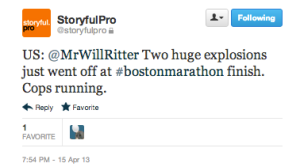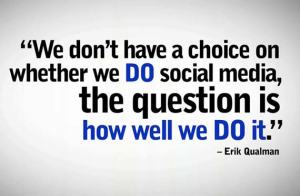According to Professor Jay Rosen of New York University, citizen journalism is conducted when “The people, formally known as the audience, employ the press tools in their possession to inform one another.” I believe this statement is true to a certain extent. Today we are living in a highly digitized global village where like McLuhan predicted “time has ceased and space does not exist”. Technologies such as smart phones and mediums such as blogs and twitter exasperate thoughts and knowledge of social, political, cultural and economic trends. Thanks to this media the citizen or audience has become a producer of user generated content and stories. Marginalized citizens, minority groups or anyone really can simply point and shoot content which acts as a democratic agent much alike the best form of news. Citizen journalism bridges the gaps in time and space by having someone there on hand who is ready and able to obtain content and potentially tell the story. A prime example is the Boston bombings of 2013, a combination of user generated content and social media helped the leading news organizations cover an unexpected and breaking story.
On the other hand citizen can bring out the worst in journalism to a certain extent. User generated stories are not subject to the best practices of journalism. UGS can contain bias which goes against the notion of fair and balanced reporting. In addition the speed and ease embedded within the process means that most of the information has not been fact checked. Bulkley says it’s hard to judge amateur content online against a “considered documentary broadcasted on traditional television channel” Citizen content being passed onto a journalist with an appropriate fee reached would serve journalistic standards. From here professional practices of journalism can be applied to the content to create a story. Indeed, UGS are highly liberating but there is never an enforced set of guidelines to make the citizen aware of the stories they produce and their implications. This both points to potential legal issues for the citizen UGS but on the other hand their creativity has not been stifled.
References:
Bulkley, Kate 2012 ‘ The rise of citizen journalism’, Available At: https://d2l.deakin.edu.au/d2l/le/content/209569/viewContent/2333749/View , Accessed 28/8/14
The Hot and Coll Interview in: McLuhan, M. Media Research: Technology, Art and Communication, Available at: http://encore.deakin.edu.au/iii/encore/record/C__Rb2971220) pp 89, Accessed 22/8/2014
Rosen, Jay ‘Definition of Citizen Journalism’, Available at http://www.youtube.com/watch?v=QcYSmRZuep4.






